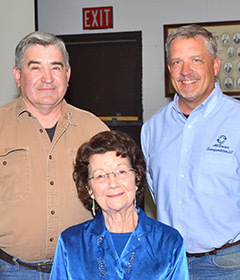Polio survivor’s fight to live a normal life

Peggy Tingle with Neal Beard (left) and
Keith Rohling, president-elect of the Lawrenceburg Rotary Club.
By Neal Beard, a member of the Rotary Club of Lawrenceburg, Tennessee, USA
“I was 18 when I contracted the disease,” Peggy said, as she spoke into a lowered, stationary microphone set up at the front of our meeting room.
She spoke from a motorized wheelchair, reading from her notes.
Peggy was the guest speaker at our club meeting recently, and her story underscored for me why we need to remain committed to eradicating this terrible disease of polio. Statistics are one thing, but when you hear someone’s story who has battled the disease, it takes your emotional resolve to a completely different level.
“I had been married for three years and had a one-year-old daughter when I contracted polio,” Peggy continued.
“One evening my husband and a couple of friends went on a night fishing trip. We girls decided our treat would be to go out and eat burgers and shakes and smoke a cigarette. This was during the ‘50’s…The next morning I woke up very nauseated with a severe headache that quickly got worse. The next day my neck was stiff and very painful. My husband carried me to the doctor, who put me in the hospital for a week of test, but they couldn’t determine what was wrong. I talked the doctor into letting me go home, but when I stepped up to go inside, my knee collapsed and I fell to the floor.”
In the polio ward
Peggy saw another doctor who suspected polio and sent her to Nashville’s Vanderbilt Hospital, which confirmed it, beginning a year and a half of therapy at the hospital’s polio treatment center.
“Vanderbilt had an entire floor that was the polio ward. Many people, all ages, from several states were there. They had iron lungs, rocking beds, and portable breathing machines to help the ones who needed it. There was only one elevator to that floor. There was a little open-air room you could visit with relatives on the weekends.”
“I never cried, even when the therapy was very painful. Sometimes a tear would fall out, but one day the main doctor came in and rubbed a sharp instrument on the bottom of my foot. I was able to feel some of it. Then he said, ‘Wiggle your big toe for me.’ I tried my hardest to move my big toe but it would not move. That’s when I finally broke down and cried. To this day, I still cannot move that big toe.”
Peggy was eventually able to return home, where she continued therapy there with the use of braces. The doctors initially told her husband that she would never walk again, but he kept that opinion from her for more than 20 year. Without that to deter her, she eventually learned to walk again, with only a slight limp and halting step.
“I wanted my family to have a normal mom and a normal life too,” she said. “If the school asked the parents to send a cake or pie for some event, I would send them two. My daughter said that she never knew that I was crippled until she attended college.”
Post-polio syndrome
A few years ago, Peggy began to lose the strength in her legs and her overall endurance began to wane. Post-polio syndrome, a wearing out of the good muscles that have been overused to compensate for the atrophied ones, had set in.
She finally had to accept the fact that she needed a motorized wheelchair to get around. In addition, she purchased a specially designed mini-van with sliding side door and access ramp. It is even equipped with hand controls for braking and acceleration to allow her to drive.
Peggy’s story moved our members to donate more than $3,000 to the PolioPlus campaign and our club isn’t finished yet. I hope her story will motivate you to help us End Polio Now.
Thank you and God bless you Peggy Tingle.